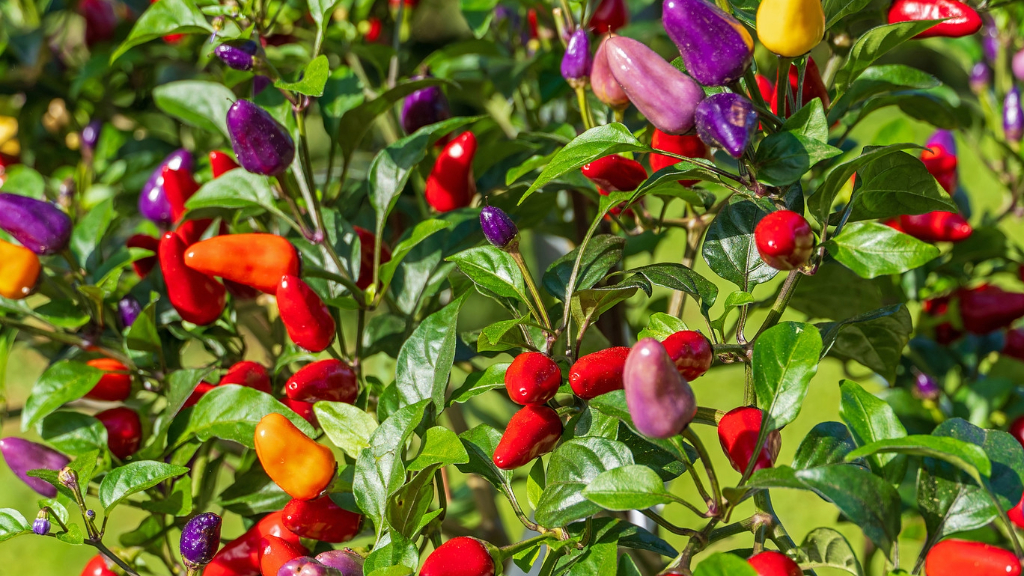Learn About Chinese Five Color Peppers

I like a plant that is multi-talented and Chinese 5-color pepper plants fits the bill. Rather like an entertainer who is a "triple threat," Chinese 5-color pepper plants are not only gorgeous but produce brilliantly colored, edible fruit. These heirloom hot peppers are fairly easy to grow and under the right conditions produce enough peppers to spice up a year's worth of dishes. Read on to find out more about Chinese five color peppers.
Chinese 5-Color Pepper History
Chinese 5-color pepper history begins in, you guessed it, China. These screamingly hot little peppers are members of the Solanaceae family. They are considered to be heirloom hot peppers and hot they definitely are! Like all peppers, Chinese 5-color pepper plants are warm season annuals. They can be grown outdoors in warmer climates or potted and grown outside during warm months and then brought inside when temps chill. In fact, this ornamental pepper is often for sale around the winter holidays, sold as an ornamental plant.
More Info about Chinese Five Color Peppers
Chinese 5-color peppers are cone peppers. The plants are upright, branched with rigid, delicate stems and thin green leaves with lovely purple stems and veins. The flowers are insignificant but the resulting fruit more than makes up for that. Fruit is conical in shape, and starts out purple but as it matures runs the rainbow gamut from cream, yellow, orange and finally red when ripe. The peppers do not ripen all at once, so the resulting plant becomes a kaleidoscope of the five colors, continually evolving as the peppers mature. Chinese 5-color peppers are heat loving plants hardy to USDA zones 5-12. If you live in the cooler end of the spectrum, be sure to wait until the soil is warm and nighttime temps are well above freezing (above 50 degrees F. or 10 C.) before moving it outside. Chinese 5-color can be planted from seed or purchased already growing. If you buy a Chinese 5-color from a store that is selling them as ornamentals, be aware that the plant may have been treated with chemicals or pesticides, so don't eat the peppers! As with other types of ornamental peppers, Chinese 5-color will only grow about a foot high and a foot across, making it perfectly suited for container growing. Also, growing this heirloom hot pepper in a pot makes it easy to move indoors or into shade depending upon the temperature. Choose a full sun area to plant your Chinese 5-color. Use a well-draining potting soil or loamy and sandy soil with a pH of 7.0-8.5 if you are planting directly into the garden. Keep the plant consistently watered, especially if the plant is container grown. The multihued peppers will be ready when they turn red, about 85 days or so to maturity. Just snip them off with scissors or garden shears when you are ready to use them. This little heirloom hot pepper can be quite prolific, but no worries. Peppers can be used immediately or, if you are drowning in them and can't give enough away, freeze them or dry them for later use. Another great idea is to make a batch of hot sauce which will last a long time and it also makes a great gift!
Gardening tips, videos, info and more delivered right to your inbox!
Sign up for the Gardening Know How newsletter today and receive a free copy of our e-book "How to Grow Delicious Tomatoes".

Amy Grant has been gardening for 30 years and writing for 15. A professional chef and caterer, Amy's area of expertise is culinary gardening.
-
 Looking For Plants To Give You The Soft And Fuzzies? Try These 5 Fuzzy Leaf Plant Options
Looking For Plants To Give You The Soft And Fuzzies? Try These 5 Fuzzy Leaf Plant OptionsLovers of texture, drama, silver foliage and tactile plants will adore these special sensory garden additions. These fuzzy leaf plant options will leave you all aglow
By Susan Albert
-
 Get Ready For A Summer Of Hummers! Grow These Full Sun Hummingbird Plants and Flowers
Get Ready For A Summer Of Hummers! Grow These Full Sun Hummingbird Plants and FlowersIf you’re lucky enough to enjoy a sunny backyard, make sure you are maxing out on your pollinator opportunities and grow these full sun hummingbird plants and flowers
By Tonya Barnett